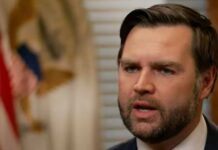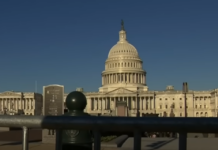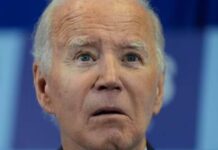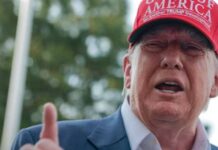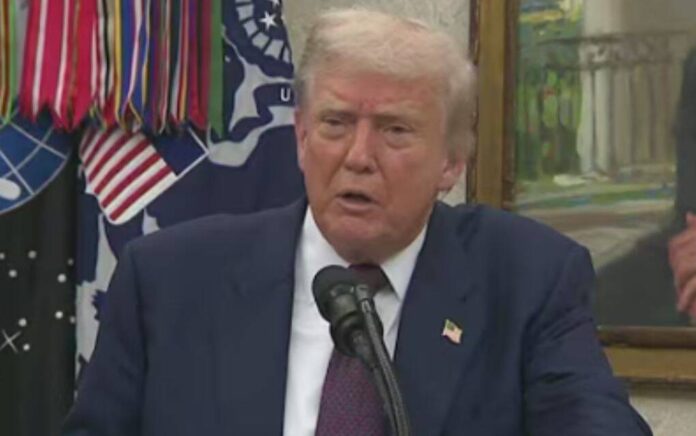
Donald Trump is not one to back down from a fight. But he’s willing to hear reason.
That’s why President Trump has made this critical announcement about his tariffs strategy.
Trump Outlines Tariff Plan to Boost U.S. Chip Manufacturing
During a Wednesday press briefing in the Oval Office, President Donald Trump announced that chips and semiconductors produced abroad will face a roughly 100% tariff, while those manufactured in the United States will be exempt.
Since kicking off his 2024 presidential campaign, Trump has emphasized revitalizing American manufacturing to create jobs and encourage foreign companies to invest in U.S. production. At a briefing focused on Apple’s new $100 billion commitment to American manufacturing, he proudly noted the trend of companies returning to the U.S.
“It’s companies like Apple, they’re coming home,” Trump said. “They’re all coming home, and we want them to come home. They have to come home. We’re going to treat them really well. We’re going to be putting a very large tariff on chips and semiconductors. But the good news for companies like Apple is if you’re building in the United States or have committed to build without question, committed to build in the United States, there will be no charge.”
“In other words, we’re not going to be charging. So a lot of countries, a lot of companies are leaving various other places, and they’re coming to the United States. So in other words, we’ll be putting a tariff of approximately 100% on chips and semiconductors. But if you’re building in the United States of America, there’s no charge, even though you’re building and you’re not producing yet in terms of the big numbers of jobs and all of the things that you’re building. If you’re building, there will be no charge.”
Since Trump’s return to the presidency, major technology firms have begun relocating operations to the U.S. due to concerns over trade uncertainties. In April, Trump introduced his “Liberation Day” policy, which imposed significant reciprocal tariffs on several nations.
Following the policy’s rollout, Trump granted a 90-day tariff suspension to allow nations to negotiate trade agreements with the U.S. That same month, companies like Advanced Micro Devices revealed plans to produce chips at Taiwan Semiconductor Manufacturing Company’s Arizona facility, marking the first time their processors would be made in the U.S.
“I didn’t even tell you that inside,” Trump said to Apple CEO Tim Cook. “We discussed the concept, but I didn’t. So it’s a big factor. So 100% tariff on all chips and semiconductors coming into the United States.”
“But if you’ve made a commitment to build or if you’re in the process of building, as many are, there is no tariff. OK [and] if for some reason you say you’re building and you don’t build, then we go back, and we add it up. It accumulates, and we charge you at a later date. You have to pay, and that’s a guarantee,” Trump said.
Apple’s $100 billion investment follows a $500 billion commitment made in February, which includes hiring 20,000 American workers over the next four years and establishing an artificial intelligence server factory in Texas.
Understanding Donald Trump’s Tariff Strategy
Donald Trump’s tariff strategy, as articulated in his recent statements, centers on using high tariffs to incentivize domestic manufacturing, particularly in critical industries like semiconductors. The approximately 100% tariff on foreign-made chips aims to make U.S.-based production more economically viable, encouraging companies to build factories and create jobs in America.
The strategy builds on Trump’s long-standing belief that trade imbalances harm the U.S. economy. During his first term, he imposed tariffs on steel, aluminum, and numerous Chinese goods, citing national security and economic concerns. The current focus on semiconductors reflects their strategic importance in technology, defense, and emerging fields like artificial intelligence. By exempting U.S.-produced chips from tariffs, Trump aims to create a competitive advantage for American manufacturers.
This policy responds to global supply chain vulnerabilities exposed during recent years, including chip shortages that disrupted industries like automotive and electronics. The U.S. share of global semiconductor production has declined significantly since the 1990s, with Asia, particularly Taiwan and South Korea, dominating the market. Trump’s tariffs are designed to reverse this trend by making foreign chips cost-prohibitive and encouraging investment in domestic facilities.
Apple’s $100 billion investment and Advanced Micro Devices’ Arizona production plans demonstrate early industry responses to the policy. These moves follow significant government incentives, such as the CHIPS and Science Act of 2022, which allocated over $50 billion to support U.S. semiconductor manufacturing. Trump’s tariffs complement these efforts, creating a dual mechanism of penalties for imports and rewards for domestic production.
The 90-day tariff suspension Trump announced in April allows time for trade negotiations, indicating a pragmatic approach to balancing protectionism with global trade relations. This flexibility aims to prevent immediate economic disruptions while pressuring foreign companies to establish U.S. operations. However, critics argue that such high tariffs could increase costs for consumers and industries reliant on imported chips, potentially slowing innovation.



